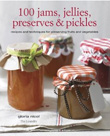BLOOD ORANGE AND PINK RHUBARB
Sunday February 02nd 2014, 2:52 pm
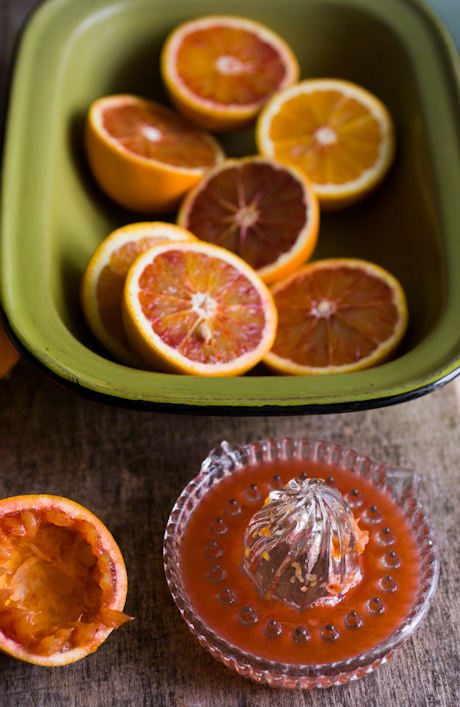
I haven’t posted on my blog for ages, so long in fact that I’ve forgotten how. This morning I found myself eating marmalade straight from the jar with a spoon and savouring the flavours; a fresh citrus hit with a tangy aftertaste. I could smell the light scent of cardamon from the jar, but should it perhaps be stronger in the syrup? Savouring and ruminating. The overall result was a good one creating an instinctive response to down another spoonful. So it seemed a fitting time to share the recipe. I have deemed this preserve a success and love the idea that others will enjoy it too.
Last week my quest for new season citrus gave the perfect excuse, in case one were needed, to treck off to Monmouth to see what Munday & Jones, my favourite local greengrocers, had to offer. They did not disappoint with a crate of blood oranges and some super perky looking early Yorkshire rhubarb on sale, the colours of which were enough to instantly lift my heart, but then I am after all a fruit geek.

I decided to make a marmalade that is a variation on a previous recipe from 2011, pink grapefruit, rhubarb and cardamon marmalade, simply substituting blood oranges for the ruby grapefruit. Yorkshire rhubarb doesn’t come cheap, so this is a good recipe to make a small amount go a longer way. It also meant I had a few sticks left over to make an upside down polenta cake as well.
As I mentioned, I am still undecided whether the cardamon could do to have a bit more impact. I freshly ground the spice in a pestle and mortar, placing it pods and all in a muslin bag to macerate with the rhubarb. Perhaps the cardamon I have could be fresher, who knows? I might buy some new for next time I make this marmalade. But still, too much cardamon would not be good either. It is always a very exacting thing when using spices and herbs in preserves, but better to underdo than over. Of course the ideal is to get it bang on!
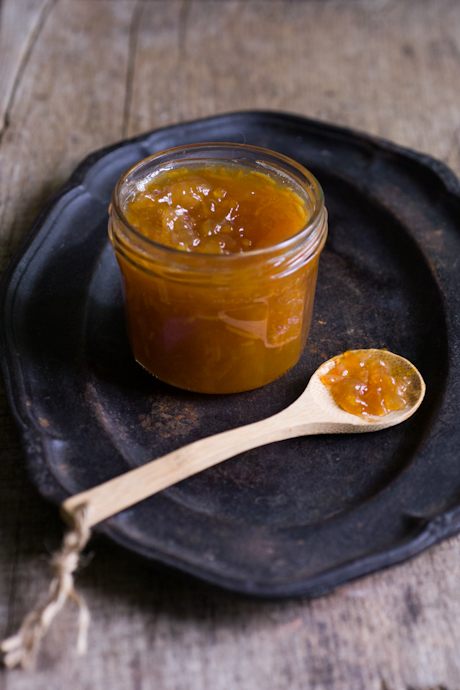
BLOOD ORANGE, RHUBARB AND CARDAMON MARMALADE
Makes approx 1.3kg (3lbs)
0.4Kg (1lb) rhubarb
1kg (2.2lbs) sugar
juice of 1 lemon
seeds from 14 cardamom pods, crushed
800g (1.75 lb ) blood oranges
Rinse the rhubarb stems and chop into 1cm (1/2 in) evenly sized pieces, slicing thicker stems lengthwise to make the pieces uniform. Place them in a bowl with the sugar and lemon juice. Tie the crushed cardamom seeds, pods and all, in a piece of muslin and push them inbetween the rhubarb, then cover with baking paper or clingfilm and leave overnight or for up to 24 hours, so the juices ooze out of the rhubarb and turn the sugar to syrup.
Wash the blood oranges and remove the peel with a sharp knife or potato peeler, leaving as much of the pith on the fruit as possible. Finely cut the peel into shreds. Squeeze the fruits, collecting the juice and tie the remaining pulp, pith and pips together in a muslin bundle. Place the shreds, juice and bundle in a pan, add 1.4ltr (2 1/2pt) water and simmer for 2 – 2 1/2 hours until the peel is cooked through and tender. Remove the muslin bundle and, when cool enough to handle, squeeze the juice from it back into the pan, then discard. Pour the peel through a sieve and collect and measure the liquid, adding more water if necessary to make it up to 1ltr (1 3/4 pts).
Prepare the jars and canner if you plan to hot water process the marmalade, otherwise, make sure your jars and lids are clean and place them in a warm oven to heat and sterilise. Place the cooked shreds, cooking liquid and the contents of the rhubarb bowl in a preserving pan and bring slowly to the boil, stirring to make sure all the sugar is dissolved. Bring to a rolling boil and cook on a high heat until setting point is reached, that is when a small blob of the syrup on a cold plate quickly forms a skin when you run your finger across the surface. It took me 20-25 minutes for the marmalade to reach setting point at a fast rolling boil, showing 104C (220F) on a thermometer. Remove the cardamom bundle.
Fill the jars, leaving the appropriate amount of headroom for canning, and seal. Hot water process for 10 minutes, then remove from the canner, leave till cold and test that the lids are sealed. Label and store. Alternatively, without canning, top jars with sterilised lids or use traditional wax paper circles and cellophane with elastic bands to seal. This marmalade should store safely without canning, but hot water processing will make doubly sure that your jam will keep and store without a hitch.
CANNING FOR BEGINNERS WORKSHOP AND MEAL
Tuesday February 26th 2013, 5:12 pm

Our London canning event is now just days away. There are a few tickets still remaining so you still have the opportunity to learn about canning and bottling, how to stock your own pantry and then make fabulous meals inspired by your glorious comestibles.
To book your ticket, follow the link here. I will be bringing along an assortment of my own preserves, pickles and relishes so we can enjoy matching flavours and coming up with the perfect combinations. Kerstin and I will be preparing a banquet from jars. I would love you to be as inspired by food in jars as I am.
More information about canning and the event in my last blog post here.
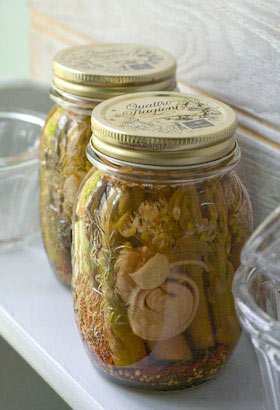
Just Mad About Canning
Wednesday February 13th 2013, 10:38 pm
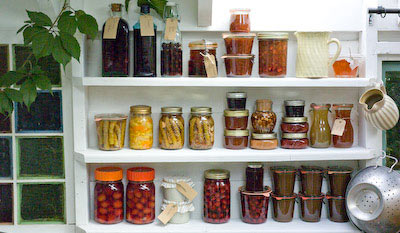
I’ve been a keen jam maker for donkeys years. Since I was 20, it’s been rare that a summer has passed by without a batch of strawberry or damson jam reaching setting point in my little kitchen. I love the tradition and never tire of celebrating the berry season each year. A few years ago I started **canning and learnt of a life beyond … jam.
Jam is lovely, and all that, and I’m still jam making with avengeance, but once you know how to can or bottle stuff in jars, it opens up another preserving dimension altogether. I now ‘put up’ all kinds of compotes, purees, pie fillings, cordials, syrups and ketchups. Sometimes I preserve fruit without any added sugar at all so my beautiful jarred comestibles become potential ingredients ready to turn into dishes, desserts and baked goods later down the line. More recently I’ve begun pressure canning vegetable soup and pulses made with homegrown vegetables from the plot.
**Canning or bottling enables produce in jars to be processed in such a way that the contents will become sterilised and so keep for a year or more safely unopened. The process involves immersing the filled jars in a boiling water bath or heating them under pressure using a special pressure canner. The correct technique called for depends on the acidity or alkalinity of the ingredients.
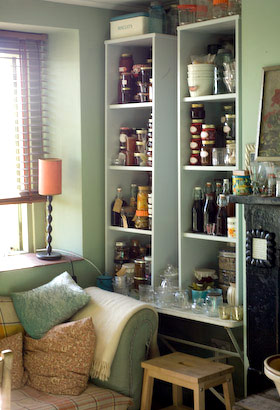
At first my ambition was to fill the shelves. A well stocked pantry or store cupboard is a thing of beauty with a real feelgood factor and the added advantage a ready supply of comestibles means you wont starve. So I filled the shelves with colourful and flavour-filled jars in tidy ordered rows till there was hardly room to fit more, all very satisfying. Then I realised the turnaround, opening jars and using up the contents, was the next vital part of the job. The scraping sound as the spoon scoops the last morsels from the sides of the jar has become music to my ears. Oh yes, an empty jar offers another opportunity, to be refilled with something even more delicious. And so the cycle continues. I’m on a voyage of discovery to find the preserves I adore and can’t get enough of. I don’t want anything nondescript taking up valuable shelf space in my house.
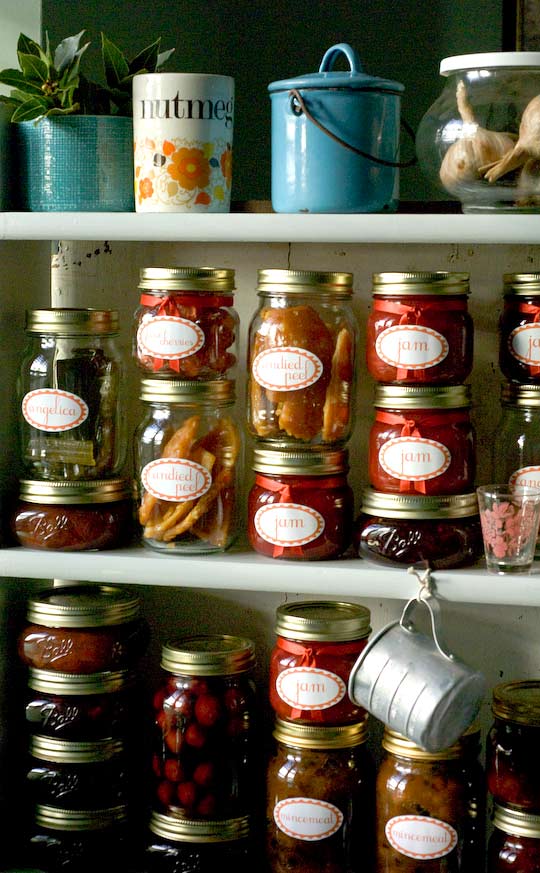
Learning how to can or bottle produce has totally changed my approach to how I source ingredients, store food and cook it. Making use of mainly homegrown or locally grown produce means naturally following the seasons and going with the flow. I feel it allows me to appreciate more living in the moment. I just love that.
Bottling fruit was once a common activity in the UK, especially during wartimes until freezing food became the easier option. Once every household had a freezer, bottling was seen as to much of a faff, all but one of the companies in the UK making the necessary equipment died a death and only a handful of diehard allotmenteers and make do and menders managed to keep the craft alive. I too own a freezer and it is filled to busting with stuff I generally forget about. I have realised that if I freeze some homegrown veg, all the while it languishes in the freezer it is clocking up additional cost. It is an expense most of us are quite prepared to accept, but with utility bills rapidly on the rise, these considerations become more relevant. Those bargain beans will have cost a fair bit more by the time I use them, that’s if I remember to use them at all of course. Alternatively, the joy of jars on shelves means once bottled the food doesn’t cost a penny more or require defrosting either. Pop open the jar and it’s ready to go. It is surely time to revive this culinary craft and give a big tick for sustainability.
But apart from all the practical reasons to love canning, the flavours are the biggest plus. I was brought up to think that preserved foods were second rate and nowhere near as tasty as fresh. What I have experienced first hand confounds these ideas. By following correct practice and keeping cooking times safe but to a minimum, you can capture the most intense and delicious flavours in a jar, capture the absolute essence of those ingredients.
These Are few of My Favourite Things :
Squashed Strawberries
With months of rain over the summer, 2012 was a difficult one for growing fruit and veg here in the UK. For a couple of weeks in July a freak strawberry glut meant strawberries were on sale at a bargain price, juicy, flavourful local strawberries. I bought loads and bottled them. They have been my favourite and most useful preserve of the year and they’ve been eaten with yogurt, rice pudding, cake … just about anything. Now down to my last couple of jars and hoping such good fortune is to be found this summer for a repeat performance. Canning means you can make the most of bargain-priced ingredients when they come your way.
Rhubarb Ketchup
I gave my recipe for rhubarb ketchup a couple of years ago and it has been a big hit with everyone who has tried it. I like to add it to my vegetarian cottage pie. I grow rhubarb anyway, so is generally in plentiful supply and I try to make enough ketchup to see me through the year. This is a good one for people with savoury tastes too.

Quince Blood Orange Cordial
Stocking up with cordials is when canning makes such sense. You can make combinations you will never see for sale anywhere and quince blood orange and coriander definitely fits that category. (For this fabulous recipe see my top-notch canning chum Shae’s blog – Hitchhiking to Heaven) Can be given added sparkle or served flat, scope is endless for a non-alcoholic tipple or as part of more potent cocktails.
Straight Bottled Morellos
Though the canning cycle naturally runs over 12 months, some people like to stock up for longer in case next year their tomato crop is destroyed by blight or unpredictable spring weather ruins the quince harvest that should rightfully follow. Most produce if bottled and stored correctly will stay good for a year or two. I’ve got a couple of jars of morello cherries bottled in 2011, still delicious and destined to become clafoutis. Fingers crossed the local cherry harvest is bountiful this summer so I can stock up again.

* I CAN SHOW YOU HOW TO CAN *
It is always so much easier to have someone who knows what they are doing to show you the ropes. Kerstin Rodgers (aka Ms Marmite Lover) has invited me to run a special canning class on 3rd March 2013 starting at 2pm, as part of The Secret Garden Club at her The Underground Restaurant, in North London, followed by a special supper focusing on food from jars.
At Canning for Beginners, you will learn all you need to know to get started; Which ingredients call for what approach, a basic sequence to follow every time you prepare your jars, how to water process high acid ingredients and a brief introduction to pressure canning for low acid ingredients and what you need to consider to keep your canning safe.
We will cover the best jars to use, how they work and what tools and equipment you will need and I will be advising on the best sources for specialist bits and pieces that are harder to find.
After bottling some fruit compote to take home, there will be a meal based around preserved ingredients.
Be prepared to be surprised by just how wonderful the flavours of preserved foods can be.
JAR MEAL (PROVISIONAL) MENU
Soup in a jar
Selection of Cheeses and individual hand pies with an abundance of pickles and relishes to go with and sample. The pickles and relishes to include jarred garlic scapes, black grape chilli jam, pickled golden beetroot with onion, rhubarb ketchup, pickled greengages, etc.
Little Cardamon or almond puddings baked in vintage French jars served with pear vanilla compote or roasted rhubarb and clotted cream.
Damson mincemeat and Bramley apple jalousie served with ginger syrup cream.
You will leave with a goody bag to take home containing a preserving jar, a pair of jar lifters and a list of useful resources as well as my suggested reading list so you feel ready to go off and stock your own pantry with wonderful things.
The event is by ticket only and there are limited places available. To reserve you place book here.
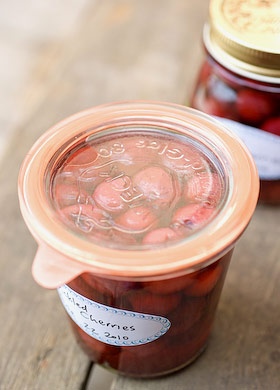
SUMMER THROUGH ROSE TINTED SPECTACLES
Tuesday July 10th 2012, 6:37 pm

For anyone reading this in sunnier climes, in the UK it has rained and rained and rained. Other countries have their rainy seasons but our monsoon season always comes as a complete surprise. Even the most determined gardeners have had their endeavours thwarted by perpetual rain. Food producers have lost their crops on flooded land. God forbid, we’re all set for a scarcity of potato crisps in the months ahead! Whatever happens, food is bound to cost us more.
I’d been waiting for a dry sunny day to go and harvest the fruit on my allotment. Despite my lack of horticultural effort this year, I have been rewarded with a fair amount of produce. The berries would no doubt have benefited from a bit more sun, or any sun, but a few days ago I was still able to pick strawberries, raspberries, white, pink, red and black currants, gooseberries and even a handful of alpine strawberries. The currants were tedious to pick and the red ones turned mouldy in an instant, before I had time to get them in the pan. So sad as they are such a glorious fruit. There are still more white currants to harvest as patience got the better of me after stripping 5 bushes. This is my first year of any kind of crop as the bushes were planted just a few years ago.
The pink currants are particularly beautiful and as this is my first opportunity to preserve them I was curious to see whether their marvellous colour would follow through in a jam. They are a variety called Gloire de Sablon. I made the simplest jam with them, just berries, sugar and water, pushed through a food mill to remove the seeds, but not dripped in a jelly bag which would have given a clearer result. The jam has the look of a jelly but with just a tad more texture, a bright tangy flavour and will be eaten with relish on toast for breakfast. All currants contain plenty of pectin, the stuff you need to help jam set, so achieving a firm set shouldn’t be a problem.
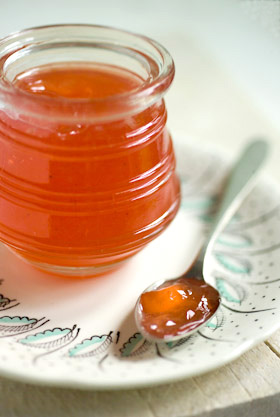
PINKCURRANT JAM
Makes approx 750g (3 x 1/2 pint jars)
550g (1 1/4lbs) pink currants
500g (1lb) sugar
300ml (1/2 pt) water
Place all the ingredients in a pan and bring slowly to a simmer, stirring all the time until the sugar has dissolved. Simmer for 5-10 minutes until the currants are cooked and burst. Take the pan off the heat, pour the contents into a bowl and leave covered overnight.
Next day push the currants and syrup through a sieve or food mill, collecting the juice and puree in a bowl underneath. Prepare your jars by sterilising them and their lids in a warm oven for 15 minutes or alternatively prepare a water bath, preserving jars and seals, if you plan to process (can) your jam.
Place the puree and syrup in a preserving pan, bring to a rolling boil and maintain to setting point, which should only take around 5-10 minutes. Skim to remove any froth from the edges of the pan, then pour into hot jars and seal. Alternatively, pour into hot preserving jars, seal and water process for 5 minutes. Remove from the water bath and leave to cool for 24 hours before testing the seals.
THE START OF A BERRY ENGLISH SUMMER
Sunday June 20th 2010, 12:02 am
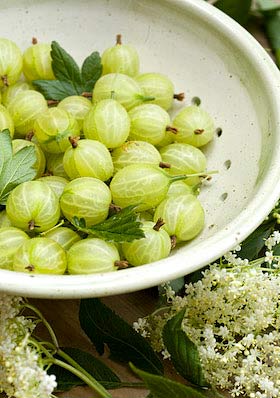
Month six Tigress’s can jam canning challenge and for June the choice of ingredients is positively bountiful with anything ending in ‘..erries’. As if that wasn’t enough, after other can jammers queried what that meant, the category was widened even further to include anything ending in ‘..urrants’ as well. I am just hoping that we haven’t covered the whole soft fruit spectrum in one fell swoop. With summer officially about to begin, at last the preserving year is shifting up a gear and a dearth is just starting to resemble a glut. After last months project, my rhubarb ketchup, that was a success but in a brown kind of way, I’ve been yearning for something colourful and British, something that sings a song of summer, con brio, whilst at the same time celebrating the beginning of the soft fruit season. So gooseberries it is.
I have cooked with gooseberries before but not to any great extent. Gooseberries are another fruit that seem to grow easily and yet are underused and under appreciated, an old fashioned country berry with an unfashionable reputation. This is another one of those puzzling fruits that is everywhere but at the same time hard to find. You either have to grow your own or know someone else who does. I’ve recently planted a few bushes on my newly acquired allotment, and though there wont be any crops to harvest this year, hopefully they will bear fruit-a-plenty in the years ahead. Varieties come with down to earth names, like Leveller, Invicta and Pax, very much old-school allotment sounding. More recently food writers have started to feature gooseberries, so perhaps they are on the cusp of a renaissance.
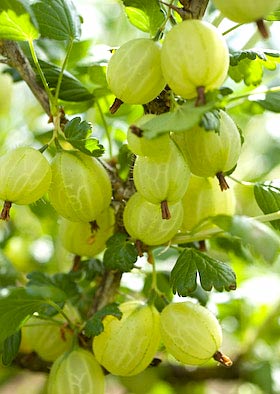
For the canjam I have chosen to make a gooseberry and elderflower jelly. There is something so pure and delicious looking about jellies and in this instance the end colour, though a glorious pinkish amber is nothing like the fresh green that the fruit starts out as. I have read that if you cook gooseberries in a copper pan they retain their green colour, but as I have no direct experience of this, I am loath to pass on the information parrot fashion. In my stainless steel jam pan, green gooseberries tend to turn an unappealing khaki colour as they cook but once the extracted juice and sugar begin to work together, an altogether more magical hue develops. Elderflowers make a classic partnership with gooseberries and should be ready for picking at the same time, though the flowers are much more fleeting. Here, in the Forest of Dean, the flowers have been in bloom for about two weeks but the berries are only just starting to ripen. I’ve used fresh elderflowers but you could use elderflower cordial instead if the only flowers to hand are past their best.
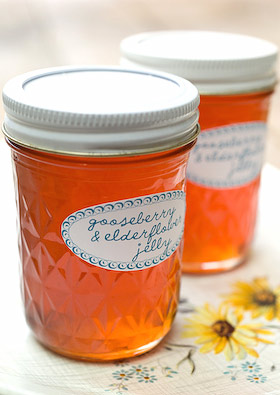
GOOSEBERRY AND ELDERFLOWER JELLY
Makes approx 1.3kg (3lbs)
2Kg (4lbs 8oz) gooseberries, rinsed and drained
approx 20 freshly picked elderflower heads
1 lemon
sugar
There’s no need to top and tail the fruit. Place fruit in a pan with 1 litre (1 3/4 pints) of water. Add the elderflowers and heat the pan, bringing to a simmer, then cook gently until the berries are soft and start to burst. Pour into a jelly bag (that has been sterilised by boiling for 5 minutes beforehand) suspended over a bowl, add the juice of the lemon and leave to drip overnight to collect all the juice. Discard the pulp remaining in the bag and measure the juice. Pour into a preserving pan and add 450g (1lb) of sugar to every 600ml (1 pint) of juice.
Prepare the water bath, jars and seals ready for canning. For more info about how to hot water process, refer to the guide here. Stir the syrup over a low heat until the sugar is completely dissolved then turn up the heat and boil rapidly to reach setting point. To test for a set, drip some syrup onto a cold plate and see if it quickly forms a skin that will wrinkle when you push your finger across the surface. Alternatively, use a jam thermometer and when it shows 105C (220F) you know setting point has been reached. (I usually employ both methods at the same time to be on the safe side!) Pour into the jars leaving required headroom for your type of jars, seal and hot water process for 10 minutes. Remove the jars from the water bath and leave them till completely cold before testing the seals are vacuum fixed. Label and store.
You can omit hot water processing if you wish as a jelly of this type should store well without, but processing makes it extra safe and will mean the jelly should keep for a year or longer.

RHUBARB FOR SALE
Friday May 21st 2010, 8:32 pm
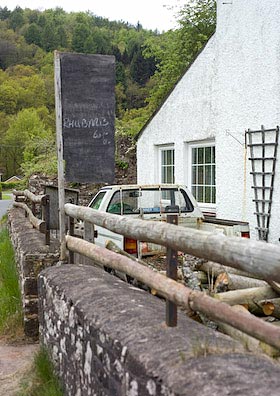
Month five Tigress’s can jam canning challenge and for May there are two ingredients to choose from; asparagus and rhubarb. Asparagus is still quite hard to come by locally. I found some in the Co-op but as it has come all the way from Peru I decided to give it a miss. I have a hard and fast rule to only buy English asparagus, which therefore means I only buy it during the 6-8 weeks that it is in season. I did buy an organic bundle in the deli here at Taurus Crafts, where my shop is situated, but it was quite expensive, so there was no way I would be prepared to mess about with such a prized ingredient other than to devour it chargrilled for my supper. So that leaves rhubarb, a crop I have already been working with for the last two and a half months but that is such a favourite of mine that I have yet to tire of it.
As luck will have it, whilst driving through the Forest of Dean I happened upon someone selling rhubarb at a very reasonable price from his smallholding. This place is a real find and I know that I will go back there often from now on, as he grows a great selection of soft fruits which will be really useful for preserving as the summer unfolds. I stupidly didn’t ask the man’s name, but will be sure too on my next visit. When I parked up and knocked on his door, my rhubarb was yet to be picked, so I knew it was as fresh as could be when the generous bundle was handed to me for a snip. Rhubarb is a strange crop. It grows really easily and can be seen in abundance in local allotments and gardens, but it is hard to find for sale and supermarkets rarely sell it. Tesco stock it most of the time but don’t always source British never mind locally. I saw it for sale earlier in the year shipped from New Zealand, which seems extraordinary when there are varieties in the UK which can grow almost all year round. So as I drove back home, with my canjam ingredient on the seat beside me, what was left to decide was what to make next.

I have already made a rhubarb marmalade, a rhubarb jam and a rhubarb cordial this year, so in the quest for something different I have decided to opt this time for a ketchup. Chutneys, sauces, relishes and ketchups are all kind of similar, except that they vary in texture and consistency. I fancied a ketchup that was smooth, with no recognisable pieces or chunks. I thought that if I kept the ingredients pale; white sugar, golden sultanas etc, I might just get away with a pinkish looking result. It wasn’t to be, as it cooked down it did take on a pinkish hue but of a beige variety. At that point I had to decide whether to stick with boring unattractive beige or whether to make the colour deeper and richer. I opted for the latter and added some balsamic vinegar. This has only a slight impact on the eventual taste of the ketchup so may seem a rather superficial consideration, but for me the downside of my ketchup is that what I have ended up with is brown. Brown, brown, brown. One of the most wonderful qualities rhubarb posesses is its colour. What a blunder, I should have made a beautiful clear rhubarb jelly instead to add to my already groaning rhubarb preserve mountain. However, now I’ve come to terms with the lack lustre appearance, the taste is making up for it. A sort of wolf in sheeps clothing scenario. I’m beginning to fantasise about dolloping ketchup on bubble and squeak, as a relish on a Double Gloucester sandwich or even with yoghurt and extra virgin rapeseed oil to dress some homegrown salad leaves. It may be brown but it is a winner all the same.
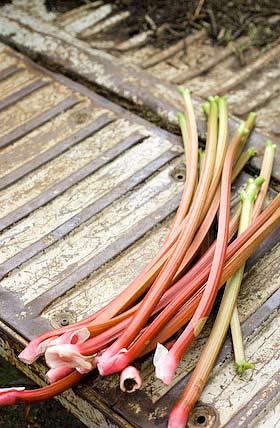
A while back I had an email from someone in the US who had bought my book. She said she was going to return the book to the shop the following day, accusing me of being ‘cavalier with ginger’. Amongst my friends, since then, this phrase has often been repeated and never fails to give us a laugh. My rhubarb ketchup is unashamedly cavalier with ginger, as rhubarb and ginger make such fine bed fellows. Obviously, if you aren’t a ginger fan, then tone it down to suit your taste. As usual when making chutneys, relishes and ketchups, that all contain vinegar, they do need a maturing phase to mellow the sharpness. This ketchup is surprisingly tasty straight away as I added some honey at the end which just takes the top edge off any harshness, but if you leave it for 3-6 weeks before opening you will find it well worth the wait. The result is fruity, spicy and I’m convinced it will be very versatile. I am not sure whether a strong enough ‘rhubarb’ vibe comes through yet, more of a lovely but general ‘fruity’ one, but I’ll see what it is like in a month or two and report back then. It is certainly worth making if you have rhubarb to spare that you hate to waste.
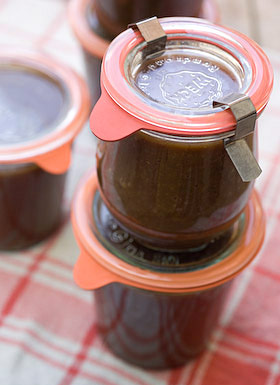
CAVALIER GINGER AND RHUBARB KETCHUP
Makes approx 1.6Kg (3 1/2 lbs)
1Kg (2lbs) chopped rhubarb
300g (10oz) onion (approx 3 med onions), chopped
325g (12oz) white sugar
1 Tbsp sea salt
600ml (1 pt) white wine vinegar
80ml (1/2 cup) balsamic vinegar
300g (10oz) raisins or sultanas
4 garlic cloves (approx 10g) peeled
4 knobs of ginger (approx 30g) peeled
2 tsp mustard seed
1 tsp allspice, ground
1tsp ground coriander
2 small dried chillis, crumbled
1/4 tsp cinnamon, ground
1/4 tsp cloves, ground
1 Tbsp honey
Place the rhubarb, onions sugar and sea salt in a non reactive preserving pan. Place the garlic, ginger, raisins (or sultanas) and vinegar in a food processor and pulse it to roughly chop everything together and break up the dried fruit. Add to the preserving pan along with the ground spices. Place the whole spices in a pestle and mortar and crush them roughly, then tip them into a piece of butter muslin, tie up in a parcel with string to secure and add to the pan.
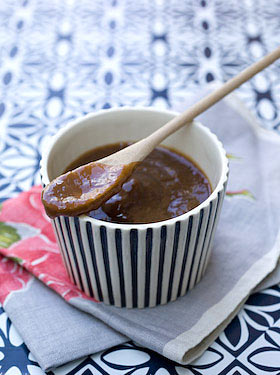
Bring to a simmer and cook until the fruit is soft, the onions are transparent and the consistency is beginning to thicken. Remove the spice bundle and push the contents of the pan through a sieve or use a food mill with a fine mesh, collecting the resulting smooth mixture. (This part of the job took rather longer than I’d have liked. Next time I will probably wizz the mixture in a blender or food processor first so it passes through the sieve faster.) Return to the pan.
Prepare the water bath, jars and seals ready for canning. For more info about how to hot water process, refer to the guide here. Add the honey to the mixture and stir. Bring the contents of the pan to a simmer and cook further if necessary until the ketchup is of a suitable consistency, like tomato ketchup. Pour into the jars leaving required headroom, seal and hot water process for 10 minutes. Remove the jars from the water bath and leave them till completely cold before testing the seals. Label and store. Leave the ketchup for at least 3 weeks before using. Without water processing the ketchup will still keep for several months unopened.
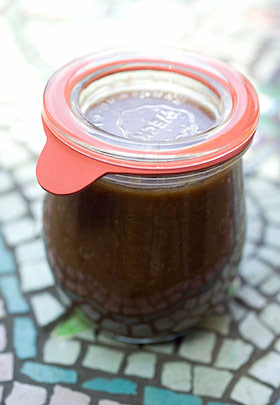
LOST IN TRANSLATION
Friday January 22nd 2010, 6:15 pm
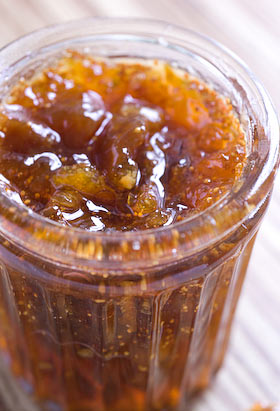
When I was a kid, my friends aunt, who was some sort of food scientist, told me that if you looked at an apple with a bad patch on it, under a microscope, you would see that the badness goes far beyond the brown bit, like spreading mycelium or the roots of a plant. This information was told as a warning, to not think it enough to just cut away the bad part and eat the rest, as what lurks beneath unseen might kill you! As I say, I am recalling a childhood memory here to dramatic effect.
Needless to say, I have always remembered this advice yet always chosen to ignore it. I was brought up to be made of sterner stuff. I follow a scale of food offness of my own design and ‘it hasn’t done me any harm’. I know that there are others whose standards in this regard are much higher than mine and just in case you are by now doubting my credentials and casting aspersions on my forthcoming artisan preserve venture, I do have an official food hygiene certificate.
For 2010, I, along with around 130 others, am taking part in Tigress’ Can Jam Challenge, an idea devised by fellow US based blogger tigressinajam, (see also tigressinapickle). The idea, to choose a different seasonal ingredient each month that can be canned. You can read the challenge outline here. It is all about ‘canning’. In the UK we don’t ‘can’ anyway, we ‘bottle’ and even that is a niche activity. Bottling, in case you don’t know, is a way of preserving food in special glass jars by employing either a hot water bath on the cooker hob or an oven method so the foodstuff is rendered sterile and will thus store in your larder for ever more. Bottling was once popular in the UK, especially during the wartime ‘make do and mend’ era. It went right out of fashion with the advent of the freezer but now seems to be making a come back with the move back to home grown fruit and veg and other eco considerations. As I am keen to know all about it, even though I am generally of the ‘scrape any mould off the top then eat the jam beneath’ school of thought, I intend to embrace the challenge and run with it.
As regular readers will already know, I am a passionate jam, chutney and pickle maker, all activities which in the US seem to come under the canning umbrella but that here somehow don’t. Basically putting your preserves through this canning process will make doubly certain that they will keep and not become contaminated. Canning requires the use of special Kilner jars (or Mason Ball jars in the US) which need new seals every time you use them. These traditional style jars, invented in 1842, have recently been reintroduced and I sell them in my shop. Unlike in the US, you can’t buy complete canning kits here with all the bits and bobs you need to get started, but you can buy some of the equipment, the rest you have to improvise. Anyhow, as the year unfolds I will be able to write about what I discover.
In order to meet the criteria of the challenge, it does mean that any preserves I make must be processed in a hot water bath, or at least I must say they are! Have you lot in the States not heard of the cellophane circle and elastic band method of sealing your jam?
January has a citrus theme. It must be wonderful to pick your ingredient straight from the tree, as some of the other challenge participants are able to do. I had to buy my fruit as none is grown here. Here is my first recipe for the 2010 Tigress’ Can Jam Challenge.
LEMON, FIG & LAVENDER MARMALADE
I am a massive fan of traditional bitter seville orange marmalade and this marmalade is just as tangy and fabulous. The lavender note adds an unusual flavour but isn’t at all over powering or over flowery. A few words first on ingredients; choose lemons that are organic where possible and unwaxed always, for this preserve. I had trouble finding dried figs without a load of gloop surrounding them, as they seem to be sold like this in supermarkets for ready-eating. Eventually I found some really nice dried Lerida figs in the health food shop. Dried lavender can vary a lot. I sell Snowshill lavender, grown in Worcestershire, sold by the scoopful in my shop and it is highly scented and natural. If you can’t find one with a good fresh scent, then please just leave it out; if you use it, it wont bring anything useful to the party.
Makes 1.3kg (3lb)
5 unwaxed lemons, approx 600g (1lb 5oz) plus 1 other lemon
400g (14oz) dried figs
25g (1oz) dried lavender
1kg (2lbs 4oz) sugar
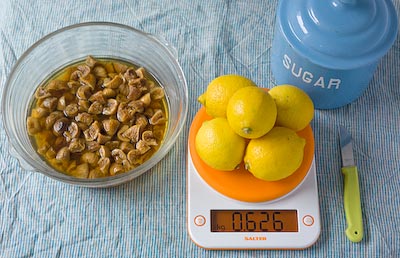
Heat the oven to 180C/ 350F/ Mk 4. Wash the 5 lemons and place in a lidded heat-proof casserole with 650ml (1 1/8pts) water, so the fruits just begin to float. Bring to a simmer, put the lid on and place in the oven to slow cook for 2 1/2 to 3 hours.
Remove the stalks from the figs and chop them into 1cm (3/8in) sized pieces (or smaller or bigger as you like, remembering they swell up as they reconstitute). Place in a preserving pan with 650ml (1 1/8pts) of water and leave them to soak while the lemons are poaching.
Remove the casserole from the oven and lift the lemons carefully with a slotted spoon out of the liquid into a sieve placed over a bowl to catch any drips. Leave them till cool enough to handle then cut each lemon in half and scoop out all the innards, collecting all the pulp and pips in a piece of muslin. Tie the muslin into a bundle and add to the preserving pan along with the poaching liquid and any liquid collected in the bowl. Chop the lemon skins finely into strips and keep on one side. Tie the dried lavender in another piece of muslin to make a bundle and add that also to the pan. Bring to the boil and simmer for 20 minutes.

Take off the heat. Remove the pulp and pip bundle and add the chopped lemon peel as well as the juice from the remaining lemon, passing it through a sieve to remove any pips if necessary. Add the warmed sugar and stir until completely dissolved then heat, bringing the pans contents to a rolling boil and test for a set after about 10 minutes and every 3-5minutes after that until setting point is reached. If you haven’t ever done this before this means that a blob of the syrup on a cold plate will readily form a skin that wrinkles when you push your finger across it. Take the pan off the heat whilst testing.
Turn off the heat, remove the lavender bundle and leave the jam to rest for 15 minutes then stir to distribute the pieces evenly before pouring into hot, clean, sterilised jars. Seal with either waxed paper discs and jam pot lids or the bottle seals and screw tops if intending to hot water process, in which case place the jars in the water bath and process for 10 minutes. For more info about how to hot water process your preserves, refer to the guide here. Leave your jars until cold and don’t forget to label and date them.
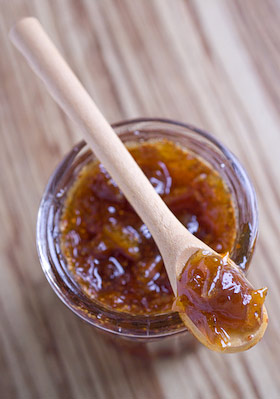
A VERY FINE JAR
Sunday August 16th 2009, 12:31 pm
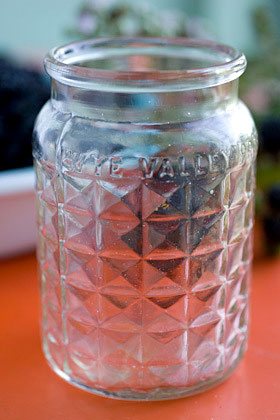
If you find an empty jam jar exciting, you are a very lucky person indeed. It surely means that you can appreciate the simple things in life that make just living a rich experience. Well that’s my theory anyway.
A recent editorial in the Telegraph for The Laundry showed an image of the vintage French Jam jars that I stock in the shop. When you get a bit of publicity like that you realise that you are not alone in your appreciation of the glass jar, as lots of people got in contact keen to get hold of some. (By the way, I sold the ones I had really fast but more are on their way from my French jar hunter, so I’ll be in touch again very soon.)
I’ve been working on how I want my own range of preserves to look, that I intend to sell here at The Laundry. The range will be called Glut Kitchen and I’ve been looking for the right jars and lids to use as well as thinking about the feel that I want the branding to create. This is all before any jam gets made. Once you start thinking in this way you realise the limitations. It isn’t a matter of finding the loveliest jar you can, as you can bet your life it will be far to expensive and impractical to use, making the end price for a jar of jam way over the top.
I thought you might like to see this vintage jar I recently acquired. It isn’t French this time, it’s British. Yes once upon a time we made such things and did a great job of it. Not only does it have a nice faceted pattern around the sides but it says ‘Wye Valley Preserves’ around the rim. The jars I choose for my own range wont be anything like as fancy as this and I doubt that in years to come someone will be waxing lyrical about an old Glut Kitchen jar, but fingers crossed they will remember the taste of the jam it contained.

LIFE, LIVING AND LAUNDRY
Saturday October 27th 2007, 5:20 pm
Calling a blog ‘laundryetc’ I suppose there is a danger that readers will expect laundry tips and advice. That is not in fact my intention (though ‘never say never’ in case some uplifting snippet of household lore comes my way). I feel that cliched path is already well trodden. ‘Laundry’ for me is not so literal, it is more about what is blowing in the breeze than what is requiring attention in the utility room. Those house cleaning programmes on TV fronted by bossy matriarchs are not for me.
Since moving to the country last year after many years living in London some very fundamental things have changed in my life. I’m less likely to eat out and more likely to cook something fresh and seasonal. I’ve rediscovered and am reusing kitchen gadgets and machinery that I had forgotten I had. I’ve always loved baking but had got out of the habit. Preserving things in season has become a consuming passion. I have intensive sourdough bread weeks trying to achieve results similar to the artisan breads sold in the smart London delis I was used to frequenting. Of course I can buy posh loaves just down the road from here, you don’t have to live in London for such things (though when you live in SW2 you don’t realise that) but now I have the incentive to take the good life to another level because I’ve always been interested in making things and at the end of the day it is just so satisfying.
My old solid-fuel Rayburn is not the most glamorous example around but it came free from an old lady in the village who had reluctantly decided that her coal lugging days were over. The enamel is chipped and a little bit more falls off every time the door bangs shut, the flue snakes across the wall as the oven is on the wrong side for the position of the chimney and it is simple boring white not a fabulous colour like the newer models, but who cares, it is wonderful all the same. Concerned that burning solid fuel makes a carbon footprint the size of elephants feet I am trying to use every scrap of energy it generates to heat the water, heat the house, dry my laundry and slow cook casseroles.
I started my vegetable garden last spring so that is relatively new beginnings as I am only one season in. The plan is to build a brick oven out there as well to cook my sourdough bread in as well as the produce from the garden. I hope to show how these plans progress.
So what will this blog be about? Well all of the above really. I love things and ideas that upend the cliche, the colourful and unusual as well as being a research obsessive.
Anyhow, let’s see how things develop……
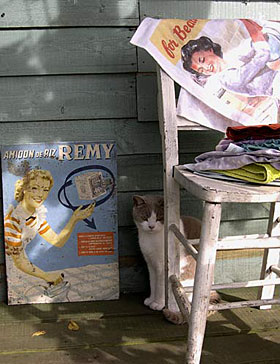
ROLAND – ONE OF THE LAUNDRY CATS





